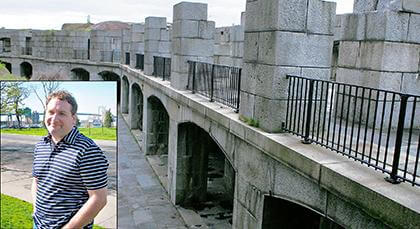By Connor Adams Sheets
Bayside’s historic Fort Totten may seem to many visitors to be little more than a relic of a forgotten era, but to independent filmmaker Matthew Crick it is something of an obsession.
Crick has embarked on the task of documenting the history, people and stories of the fort, a labor of love that began 15 years ago when he worked on the ABC program “20/20” and used the beautiful environs of the bastion for some location shots.
He was commissioned in 2002 by the U.S. Army to do the first documentary of his career — a short piece on the fort, the results of which disappointed him with its limited scope.
So the Fairview, N.J., resident set out on his own several years ago to make a feature-length film documenting the fort’s story and along the way found himself experiencing firsthand the latest chapter in the life of Fort Totten, recording it as it happened.
“One of my goals is that this feature-length documentary is a comprehensive examination and storytelling of this fort,” he said. “I want to tell the whole story right up until the final edit.”
After he began work on the film, the fort’s last remaining military unit, the 88th Regional Support Command, ceased to be stationed there, ending a long tradition of sustained military presence in Bayside. And the city Parks Department purchased 46.5 acres of the outpost’s land to create North Park.
Fort Totten is now used solely as a park, community space and training area for the FDNY and U.S. Coast Guard.
As he has delved deeper into the evolution of Fort Totten, the narrative thrust of the film has also morphed, resulting in his naming the work “Paper Tiger.”
“I chose that title because the fort never saw any battle, so it was kind of like a paper tiger,” he said. “Technology outpaced the fort’s design and development. As they built it, mortars and guns were designed that could shoot far and fast and destroy the fort. The image of a tiger is that it’s a strong beast. A paper tiger isn’t. It looks strong but it’s really not, and that’s sort of what happened to the fort.”
About 90 percent of filming has wrapped and Crick hopes to have the film finished and ready to compete in film festivals by the end of summer.
The last remaining hurdle to the film’s completion is funding. As an independent filmmaker, Crick hopes to shop the documentary to various outlets such as The History Channel or PBS, but in order to bring the project over the finish line he needs more money.
He has been reluctantly soliciting donations or investment in the project but remains optimistic money will come together and the work will move forward expeditiously.
In the end, Crick said it will pay off when the story is put to celluloid for the world to view.
“That’s what originally interested me — it’s an untold story and it’s a place that’s affected a lot of people over time,” he said. “It’s almost like the fort that never was. A lot of money was put into building these huge limestone batteries and the attack never came … but all along the way a lot of people came here and lived here and had a life.”
For more information about “Paper Tiger” or to make a donation, visit papertigerfilm.com.
Reach reporter Connor Adams Sheets by e-mail at csheets@cnglocal.com or by phone at 718-260-4538.


































